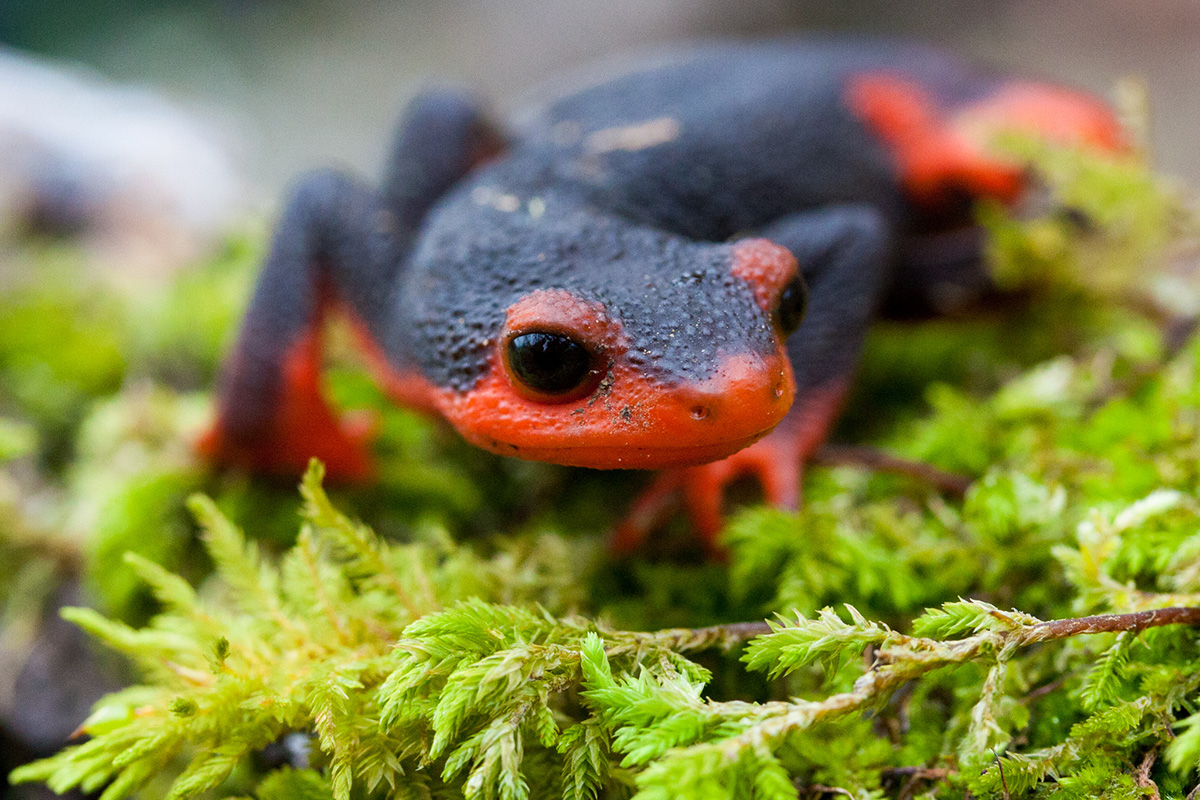The Mysterious Red-bellied Newts of Stevens Creek - Bay Nature

That February day, the rain had been steadily falling all night and into the morning; heavy drops filtered their way through the canopy, spattering on the hood of my rain jacket. Tiny rivulets made their way across the already sodden trail as we walked down to Stevens Creek. Perfect newt weather.
No flowers adorned the plants around us, a reminder that for the majority of flora and fauna here in the Bay Area, winter is not a time for reproduction. Reptiles hide underground. Even the birds migrating along the Pacific Flyway look drab, clad in their nonbreeding plumage. For amphibians, however, winter weather is as romantic as it gets. After months of hiding from the desiccating heat of summer and fall, these slimy vertebrates are finally able to stretch their legs, eat a meal, and find a mate. Adults of the newt genus Taricha make a plodding, inexorable, adorable march to their breeding waters, and these annual migrations can happen in such numbers that they famously cause the East Bay Regional Park District to close a busy road in Tilden Regional Park for much of the winter.
The Bay Area's two commonly spotted newt species are the California and rough-skinned newts (T. torosa and T. granulosa), but my friend Cynthia and I were on the hunt for what would be a new species to us: the red-bellied newt (T. rivularis). Unlike its golden-eyed cousins, this species has entirely black eyes and a vibrant red underside. And until recently, Sonoma County was the farthest south it had ever been seen, about 80 miles north of Stevens Creek.
In 2009, a trail runner had reported seeing a red-bellied newt here in Santa Clara County. Cindy Roessler, a biologist with the Midpeninsula Regional Open Space District, was skeptical at first. But she, with the help of UC Berkeley biologist Sean B. Reilly and his colleagues, found more adult newts and their eggs, confirming the watershed was home to a breeding population. These Santa Clara newts were separated from their northern kin by the daunting barriers of urban San Francisco, the brackish water of the Bay, and the Golden Gate strait. What the heck?
Want even more stories about Bay Area nature? Sign up for our weekly newsletter!
One of the first orders of business for Reilly and his team when they arrived as biologist backup was to compare DNA samples from the Stevens Creek newts with those from the main red-bellied population to suss out any genetic differences. If humans had recently introduced red-bellied newts to the area, too little time would have passed for any genetic divergence to occur. And sure enough, Reilly found no significant genetic differences in the Santa Clara newts.
So who might be the culprit? Stanford biologist Victor C. Twitty, who described the species in 1935, spent years studying it at Pepperwood Creek in Sonoma County. Perhaps he or his students had released some newts in the Santa Cruz Mountains, either accidentally or on purpose? Reilly and his colleagues asked around to no avail. In an article published in Journal of Herpetology in September 2014, they conclude that "conversations with former members of that laboratory, as well as then-graduate students in herpetology at Stanford, revealed no known newt releases in the Santa Cruz Mountains during that time."
That afternoon on the trail, I heard Cynthia cry "red belly!" and felt a rush of adrenaline. We both dropped to the ground and, sure enough, found ourselves eye to eye with an ambling amphibian with a bright red belly. Our outing was a success! We hurried to take photos of this long-sought-after and mysterious denizen of Stevens Creek. It definitely shouldn't be here, but its existence was inarguable.
(Interestingly, there are actually several other similar populations in the Santa Cruz Mountains whose nearest relatives live dozens of miles away. The Santa Cruz black salamander (Aneides niger) and the Santa Cruz long-toed salamander (Ambystoma macrodactylum croceum) are both considered to be relicts. Once part of a widespread population, they were separated by climatic or geographic changes from the rest of the species—until, over many thousands of years, they became genetically distinct.)
As we rose to our feet and made our way down the trail, the red belly continued on its way toward the creek hundreds of feet away, down the steep hillside. To the newt, there was no mystery. It knew exactly where it had come from and exactly where it was going.
Newts are very sensitive animals. Even flipping rocks or logs in pursuit of them can be detrimental to their habitat. Instead, I recommend you look for migrating newts on rainy days (or even better, rainy nights) as they cross trails and roads.



Comments
Post a Comment